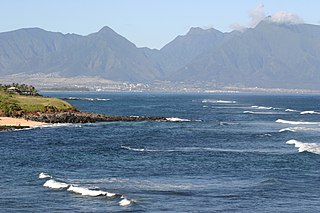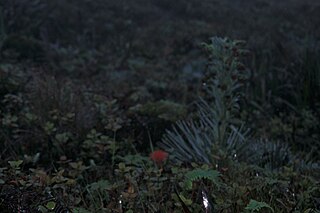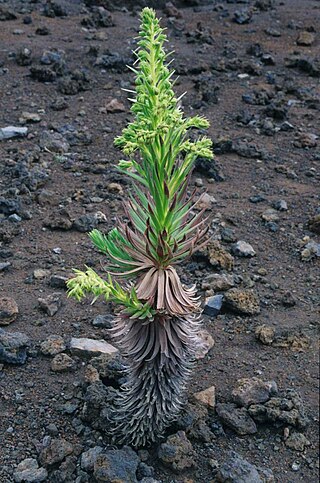
In evolutionary biology, adaptive radiation is a process in which organisms diversify rapidly from an ancestral species into a multitude of new forms, particularly when a change in the environment makes new resources available, alters biotic interactions or opens new environmental niches. Starting with a single ancestor, this process results in the speciation and phenotypic adaptation of an array of species exhibiting different morphological and physiological traits. The prototypical example of adaptive radiation is finch speciation on the Galapagos, but examples are known from around the world.
Located about 2300 miles (3680 km) from the nearest continental shore, the Hawaiian Islands are the most isolated group of islands on the planet. The plant and animal life of the Hawaiian archipelago is the result of early, very infrequent colonizations of arriving species and the slow evolution of those species—in isolation from the rest of the world's flora and fauna—over a period of at least 5 million years. As a consequence, Hawai'i is home to a large number of endemic species. The radiation of species described by Charles Darwin in the Galapagos Islands which was critical to the formulation of his theory of evolution is far exceeded in the more isolated Hawaiian Islands.

Argyroxiphium is a small genus of plants in the family Asteraceae. Its members are known by the common names silversword or greensword due to their long, narrow leaves and the silvery hairs on some species. The silverswords belong to a larger radiation of over 50 species, including the physically different genera Dubautia and Wilkesia. This grouping is often referred to as the silversword alliance. Botanist P. H. Raven referred to this radiation as "the best example of adaptive radiation in plants".

Puʻu Kukui is a mountain peak in Hawaiʻi. It is the highest peak of Mauna Kahalawai. The 5,788-foot (1,764 m) summit rises above the Puʻu Kukui Watershed Management Area, an 8,661-acre (35.05 km2) private nature preserve maintained by the Maui Land & Pineapple Company. The peak was formed by a volcano whose caldera eroded into what is now the Iao Valley.

Argyroxiphium sandwicense subsp. macrocephalum, the east Maui silversword or Haleakala silversword, is a rare plant, part of the family Asteraceae. The silversword in general is referred to as ʻāhinahina in Hawaiian.
Silver Sword or Silversword may refer to:

The silversword alliance, also known as the tarweeds, refers to an adaptive radiation of around 30 species in the composite or sunflower family, Asteraceae. The group is endemic to Hawaii, and is derived from a single immigrant to the islands. For radiating from a common ancestor at an estimated 5.2±0.8 Ma, the clade is extremely diverse, composed of trees, shrubs, subshrubs, mat-plants, cushion plants, rosette plants, and lianas.

Wilkesia gymnoxiphium, is a species of flowering plant in the family Asteraceae that is endemic to the island of Kauaʻi in Hawaiʻi. It is classified as endangered on the IUCN Red List. Wilkesia is one of three genera, with Argyroxiphium and Dubautia that are believed to be descendant from a single species related to the North American tarweed. The members of these three genera constitute what is called the silversword alliance, a group whose exceedingly close genetic heritage is not reflected in their exceptionally diverse morphologies.

Argyroxiphium sandwicense, the Hawaiʻi silversword, or hinahina is a species of silversword. It is endemic to Hawaii. The two subspecies are separated by geography. Both subspecies are rare, threatened and federally protected.

Argyroxiphium caliginis, the ʻEke silversword, is a species of flowering plant in the family Asteraceae.

The Mauna Loa silversword, Argyroxiphium kauense, or Kaʻū silversword, is a rare species of flowering plant in the aster family. It is endemic to the eastern and southern slopes of Mauna Loa on the island of Hawaiʻi. A. kauense occurs in mountainous shrublands, bogs, and open mesic forest. The species is managed by the National Park Service and Hawaiʻi State Department of Forestry and Wildlife. It is a federally listed endangered species of the United States. There are three known populations remaining, for a total of fewer than 1000 individuals.
Argyroxiphium virescens was a species of flowering plant in the family Asteraceae that was last seen in 1945. It was found only in the Hawaiian Islands where it was endemic to the eastern part of Maui. Its natural habitats were subtropical or tropical moist montane forests and subtropical or tropical high-altitude shrubland. It is officially declared extinct, but in 1989 plants were discovered that appear to be hybrids between it and the Haleakalā silversword. This hybrid is known as the Pu'u 'Alaea greensword.

Dubautia arborea, the tree dubautia or Mauna Kea dubautia, is a species of flowering plant in the family Asteraceae. A member of the silversword alliance, it is endemic to the island of Hawaiʻi. It is a shrub or small tree. It is an endangered species that is threatened by feral grazing animals.

Wilkesia is a genus of Hawaiian plants in the tribe Madieae within the family Asteraceae. It contains two perennials, both of which are endemic to the island of Kauaʻi in Hawaiʻi. Wilkesia is a component of the silversword alliance and is named after Captain Charles Wilkes.
Greensword is a common name for several Hawaiian plants in the genus Argyroxiphium, and may refer to:

Wilkesia hobdyi, the dwarf iliau, is a species of flowering plant in the family Asteraceae that is endemic to the island of Kauaʻi in Hawaii. It was first collected in 1968, and was not formally described until 1971. The number of living plants is estimated at fewer than 300. It is considered Critically Imperiled in global rank which means it is at very high risk of extinction. It has been a federally protected species since 1992. The genus Wilkesia is one of three genera constituting the silversword alliance, a group of highly diverse yet genetically exceedingly closely related species, all thought to be descended from a colonizing ancestor related to the tarweed of North America.

Argyroxiphium sandwicense subsp. sandwicense, the Mauna Kea silversword, is a highly endangered flowering plant endemic to the island of Hawaiʻi of Hawaii. It is the "crown jewel" of the volcanic mountain Mauna Kea, from which it derives its English name. The Hawaiian name is ʻahinahina; it applies to silverswords more broadly. The Mauna Kea silversword was once common on the volcano, and extraordinary conservation efforts are being made to preserve the species.
Argyroxiphium × kai, commonly known as the Kai silversword, is a hybrid species of silversword plant in the family Asteraceae, and is a part of the silversword alliance. The name derived from the Hawaiian word "kai", which translates to "sea". It was described by David D. Keck in 1936. Argyroxiphium × kai is a natural hybrid between Argyroxiphium caliginis and Argyroxiphium grayanum, so the name Argyroxiphium calignis × grayanum can also apply, but is generally less common. It is endemic to Maui, Hawaii, where it grows between other Argyroxiphium species, primarily the two species that hybridized between each other. The population of the hybrid species is unknown, although it is likely that it may be endangered, or unstable due to invasive feral goats and pigs in its natural habitat. No conservation status has been assigned to Argyroxiphium × kai by the IUCN Red List, for it is a hybrid species, so a conservation status does not apply.
Argyroxiphium virescens × sandwicense subsp. macrocephalum, commonly known as the Pu'u 'Alaea greensword is a hybrid species of silversword plant in the family Asteraceae, and is a part of the silversword alliance. It is a hybrid between two taxons of silversword plant in the genus Argyroxiphium, being the presumably extinct Argyroxiphium virescens, and a subspecies, Argyroxiphium sandwicense subsp. macrocephalum. The hybrid species was discovered in 1989, when an individual flowered, which revealed hybridization features of two species of silversword. It is endemic to East Maui, primarily near the town of Pu’u Alaea, where it is seen growing beside other Argyroxiphium species. The population of the hybrid species is unknown, but is likely under threat of feral goats, and pigs that plague silversword plants.

Argyroxiphium sandwicense subsp. macrocephalum x Dubautia menziesii, commonly known as the Dubautia-silversword, is a hybrid species of silversword plant in the family Asteraceae, and is a part of the silversword alliance. The hybrid was formed between Argyroxiphium sandwicense subsp. macrocephalum and Dubautia menziesii, which are both species of plant native to the Haleakalā Shield Volcano, Maui, primarily in the Haleakalā Crater, that grow in alpine and subalpine zones. A specimen was recorded by Karl Magnacca in 2006, although there isn't clear evidence of whom first described the hybrid species.














